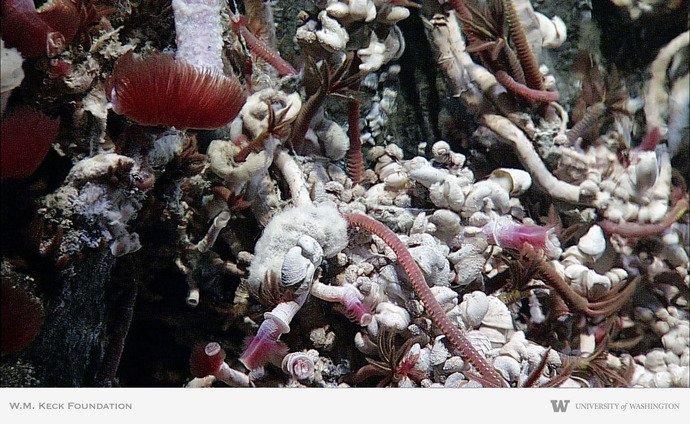The highest temperature organisms on the planet, growing at temperatures of 121°C (250°F), have been recovered from hydrothermal vents.
Deep beneath the ocean waves exist some of the most extreme environments on our planet-–hydrothermal vents associated with submarine volcanoes. The connection between volcanism and life is perhaps nowhere more evident than at mid-ocean ridge spreading centers (such as the Juan de Fuca Ridge in the Northeast Pacific). From investigation of vents comes documentation of oases of vibrantly colored tubeworm communities and arrays of clams, crabs, and gastropods that surround the volcanically driven warm vents and adjacent terranes.
Many of these macrofauna are supported by colonies of heat-loving microorganisms that thrive in the absence of sunlight. These organisms are sustained by volcanic gases released from below the seafloor. The highest temperature organisms on the planet, growing at temperatures of 121°C (250°F), have been recovered from hydrothermal vents. Such findings raise questions concerning the survival mechanisms of these organisms and the upper temperature limits of life on Earth.
Just as spectacular, however, have been observations of dramatic and massive microbial biomass being emitted from the seafloor in association with underwater volcanic eruptions. Extensive microbial blooms last for several months following these eruptions. Scientists believe that the microbes are fed by released gases associated with the injection and expulsion of basaltic material. Many of these microorganisms are archeae, believed to be the most ancient of organisms on the planet. From exploration of these systems comes the hypothesis that a potentially vast, but unexplored, microbial biosphere exists in the crust that may rival that on the continents.
Partly because the overlying ocean provides a pressure medium, mid-ocean ridges, and other active seafloor volcanoes, may represent the best natural environment currently known in which humans can study the linkages between volcanically driven hydrothermal systems and the life they support. We have only begun to explore and instrument these environments in detail; there is much left to be discovered. Understanding as much as possible about linked processes here on Earth may provide important guides to examining volcanic ecology elsewhere in the solar system.







